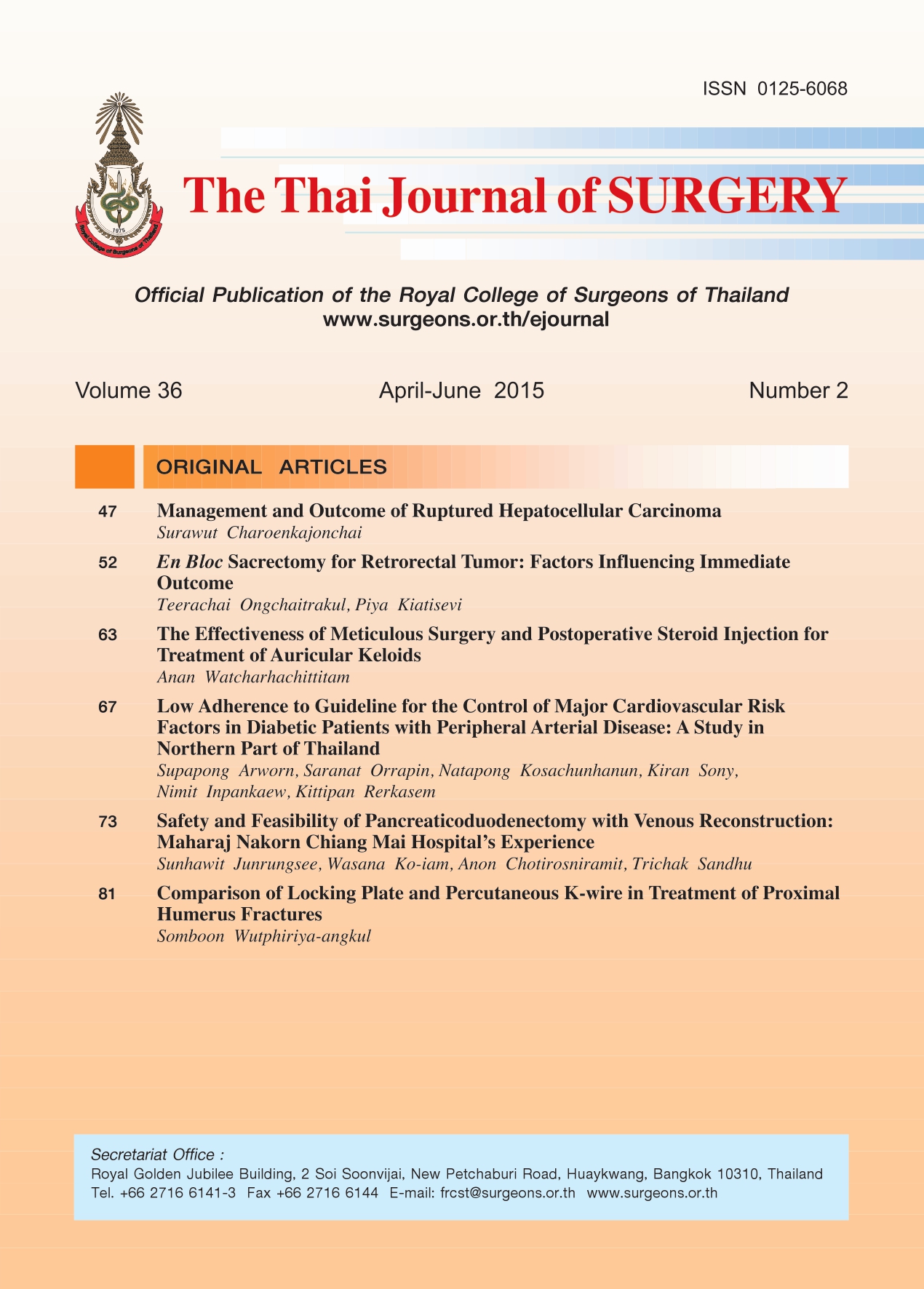Comparison of Locking Plate and Percutaneous K-wire in Treatment of Proximal Humerus Fractures
Keywords:
K-wire fixation, plate fixation, proximal humerus fracturesAbstract
Background and Objectives: The most effective method for the surgical treatment of proximal humerus fractureshas not been established. Two commonly used techniques are locking plate and percutaneous K-wire. We performed
a retrospective study to compare these two treatment strategies.
Materials and Methods: A total of 62 patients were selected for review. Each patient was treated by one of the
two methods. Data including operative time, blood loss, pain scale, neck-shaft angle, shoulder score, and operative
complications were collected.
Results: Thirty patients were treated with locking plate fixation, and the rest were treated with percutaneous
K- wire fixation. Percutaneous K-wire group was associated with significantly shorter operative time and length of
hospital stay, lesser blood loss and lower postoperative pain (P < 0.05), but had more complications (P = 0.046). There
were no significant differences in shoulder score and neck-shaft angle between the two groups.
Conclusion: Percutaneous K-wire technique is similar in effectiveness to the locking plate in the treatment of
proximal humerus fractures with a shorter operative time and hospital stay, lesser blood loss and lower postoperative
pain, but had more complications
References
proximal humeral fractures in adults. Cochrane Database
Syst Rev 2003;4:434-43.
2. Clifford PC. Fractures of the neck of humerus: A review of the
late results. Injury 1980;12:91-5.
3. Stableforth PG. Four part fractures of the neck of humerus. J
Bone Joint Surg Br 1984;66:104-8.
4. Zyto K, Ahrengart L, Sperbert A, Torknvist H. Treatment of
displaced proximal humeral fractures in elderly patients. J
Bone Joint Surg Br 1997;79:512-7.
5. Ring D. Current concepts in plate and screw fixation of
osteoporotic proximal humerus fractures. Injury 2007;3:559-68.
6. Reitman RD, Kerzhner E. Reverse shoulder arthroplasty as
treatment for comminuted proximal humeral fractures in
elderly patients. Am J Orthop 2011;40:458-61.
7. Esen E, Dogramci Y, Gultken S, Deveci MA. Factors affecting
results of patients with humeral proximal end fractures
undergoing primary hemiarthroplasty: A retrospective study
in 42 patients. Injury 2009;40:1336-41.
8. Magovern B, Ramsay ML. Percutaneous fixation of proximal
humerus fractures. Orthop Clin North Am 2008;39:405-16.
9. Bogner R, Hubner C, Matis N, Auffarth A, Lederer S, Resch H.
Minimally-invasive treatment of three- and four-part fractures
of the proximal humerus in elderly patients. J Bone Joint Surg
Br 2008;90:1602-7.
10. Krappinger D, Bizzotto N, Riedmann S, Kammerlander C,
Hengg C, Kralinger FS. Predicting failure after surgical fixation
of proximal humerus fractures. Injury 2011;42:1283-8.
11. Lau TW, Leung F, Chan CF, Chow SP. Minimally invasive plate
osteosynthesis in the treatment of proximal humeral fracture.
Int Orthop 2007;31:657-64.
12. Agudelo J, Schurmann M, Stahel P, et al. Analysis of efficacy
and failure in proximal humerus fractures treated with locking
plates. J Orthop Trauma 2007;21:676-81
13. Constant CR, Murley AHG. A clinical method of functional
assessment of the shoulder. Clin Orthop 1987;214:160-4.
14. Nho SJ, Brophy RH, Baker JU, Cornell CN, Mac Gillivray JD.
Management of proximal humerus fractures based on current
literature. J Bone Joint Surg[Am 2007;89:44-58.
15. Kenner JD, Parsons BO, Flatow EL, Rogers K, Williams GR,
Galatz LM. Outcomes after percutaneous reduction and
fixation of proximal humerus fractures. J Shoulder Elbow Surg
2007;16:330-8.
16. Siegel J, Dines D. Proximal humerus malunions. Orthop Clin
North Am 2000;31:35-49.
17. Wijgman AJ, Roolker W, Pall TW, Raaymakers EL, Marti RK.
Open reduction and internal fixation of three- and four-part
fractures of the proximal part of the humerus. J Bone Joint Surg
1970;52:1077-89.
18. Hirschmann MT, Falleger B, Amsler F, Regazzoni P, Gross T.
Clinical longer term results after internal fixation of proximal
humerus fractures with a locking compression plate (PHILOS).
J Orthop Trauma 2011;25:286-93.
19. Olerud P, Ahrangart L, Ponzer S, Saving J, Tidermark J. Internal
fixation versus non operative treatment of displaced 3 part
proximal humerus fractures in elderly patients: A randomised
controlled trial. J Shoulder Elbow Surg 2011;20:747-55.
20. Resch H. Percutaneous fixation of three and four parts fractures
of the proximal humerus. J Bone Joint Surg Br 1997;79:295-300.
21. Liu KY, Chen TH, Shyu JF, Wang ST, Liu JY, Chou PH. Anatomic
study of the axillary nerve in a Chinese cadaveric population:
correlation of the course of the nerve with proximal humeral
fixation with intramedullary nail or external skeletal fixation.
Arch Orthop Trauma Surg 2011;131:669-74.
22. Gardner MJ, Griffith MH, Lorich DG. Helical plating of the
proximal humerus. Injury 2005;36:1197-200.
23. Smith J, Berry G, Laflamme Y, Blain-Pare E, Reindl R, Harvey E.
Percutaneous insertion of a proximal humeral locking plate:
an anatomic study. Injury 2007;38:206-11.
24. Neer CS. Displaced proximal humeral fractures. I. Classification
and evaluation. J Bone Joint Surg Am 1970;52:1077-89.
25. Tanner MW, Cofield RH. Prosthetic arthroplasty for fractures
and fracture dislocations of the proximal humerus. Clin
Orthop Relat Res 1983;179:116-28.
26. Fazal. PHILOS plate fixation for displaced proximal humeral
fractures. J Orthop Surg 2009;17:15-8.
Downloads
Published
How to Cite
Issue
Section
License
Articles must be contributed solely to The Thai Journal of Surgery and when published become the property of the Royal College of Surgeons of Thailand. The Royal College of Surgeons of Thailand reserves copyright on all published materials and such materials may not be reproduced in any form without the written permission.


